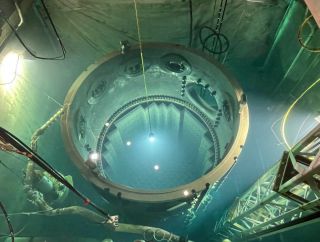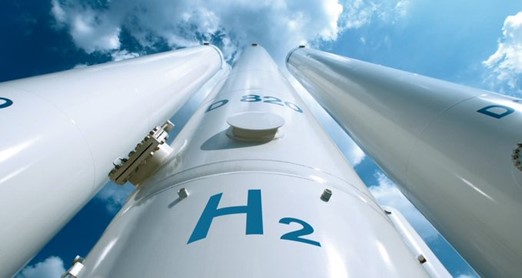The Molten Chloride Reactor Experiment will be built at Idaho National Laboratory to demonstrate criticality in a fast-spectrum salt-cooled reactor within five years. (Image: Southern Company)
A set of graphite rods was exposed to hot plasma in the DIII-D tokamak. Researchers measured the ablation behavior under extreme heat and particle flow to simulate conditions experienced by spacecraft heat shields during atmospheric entry. (Image: General Atomics)
As a spacecraft on a research mission hurtles at up to 100,000 miles per hour toward the surface of a gas giant like Jupiter, the atmospheric gases surrounding the spacecraft turn to plasma, and spacecraft temperatures increase to more than 10,000 °F.
(CLICK IMAGE TO ENLARGE) The researchers’ experimental layout is depicted here. In (b), the neutron chopper is depicted without the mesh guard shown in (d), a photograph of the experimental layout that includes the Cf-252 source tank at left. (Composite image: Joyce, et al., “Wireless information transfer with fast neutrons,” doi.org/10.1016/j.nima.2021.165946)
Swapping conventional electromagnetic radiation for fast neutrons, a team of research engineers at Lancaster University in the United Kingdom, working with the Jozef Stefan Institute of Slovenia, report that they have successfully transmitted digital information wirelessly using nuclear radiation. The researchers’ attempts to transmit words and numbers using standard ASCII code “were 100 percent successful,” according to a November 10 press release from Lancaster University. Their research will be published in an upcoming issue of Nuclear Instruments and Methods in Physics Research and is now available online.
eVinci micro reactor core, (Illustration: Westinghouse)
A recently completed feasibility study by Westinghouse Electric Company and Bruce Power concludes that the eVinci microreactor is capable of providing cost-competitive clean energy to decentralized, off-grid markets in Canada.
Research teams from the NWMO and the University of Guelph conduct eDNA sampling in the Ignace area of Ontario, Canada. (Photo: NWMO)
Canada’s Nuclear Waste Management Organization (NWMO) is working with the University of Guelph to launch a joint environmental DNA (eDNA) research program to further understand biodiversity conditions around two potential sites in Ontario for a deep geological repository for spent nuclear fuel.
LLNL and Penn State researchers developed a new approach to study and purify medical isotopes, including actinium. (Image: Thomas Reason/LLNL)
Scientists at Lawrence Livermore National Laboratory and Pennsylvania State University have demonstrated that a natural protein found bonded to rare earth elements can be recovered and used as a tool to purify and effectively manage radioactive metals that show promise for cancer therapy and the detection of illicit nuclear activities.
Physicist Suying Jin with computer-generated images showing the properties of heat pulse propagation in plasma (Image: PPPL/Jin/Kiran Sudarsanan)
Researchers at the Department of Energy’s Princeton Plasma Physics Laboratory (PPPL) have developed a new model of how heat flows within plasmas. According to PPPL, the model could improve insights into the behavior of plasmas and may help engineers avoid the conditions that could lead to heat loss in future fusion facilities.
Five sites have been shortlisted for the U.K.’s STEP fusion facility. (Image: UKAEA)
The United Kingdom has announced a shortlist of five sites as the potential future home of the U.K. Atomic Energy Authority’s (UKAEA) prototype fusion energy plant, the Spherical Tokamak for Energy Production (STEP). A final decision on the plant’s location is to be made by the U.K.’s secretary of state for business, energy and industrial strategy around the end of 2022.
This June 2021 photo of ITER vacuum vessel sector #6 includes two panels of thermal shielding ready to slide into place. (Photo: ITER/Courtesy of Chang Hyun Noh)
Following a week of heightened attention to all things hydrogen preceding Hydrogen and Fuel Cell Day (October 8), Bernard Bigot, director general of the ITER Organization, published an op-ed on October 11 in The European Files, a magazine billed as an “effective work tool for European deciders.” Bigot’s article, “Hydrogen fusion: The way to a new energy future,” doubled as a fusion primer, promoting the technology as a future source of clean energy that is fueled by hydrogen and is capable of providing heat and power to produce more hydrogen.
Balázs Bodnár, managing director of Framatome Hungary (left), shakes hands with Habil István András, rector of the University of Dunaújváros, joined by Ferenc Berki, president and CEO of Hunatom. (Photo: Framatome)
The Hungarian office of Framatome this week signed a memorandum of understanding with Budapest-based research and economic development company Hunatom and the University of Dunaújváros to work together supporting nuclear education and training, research and development, and implementation of new technologies for Hungary and surrounding countries.
Representatives of the three organizations signed the MOU during a ceremony at Hungary’s University of Dunaújváros, about 40 miles south of Budapest.
(University of Rochester illustration/Michael Osadciw)
The U.K. government has just published Towards Fusion Energy: The UK Government’s Fusion Strategy, which sets out the goal of the United Kingdom's moving from “a fusion science superpower to a fusion industry superpower,” with a prototype fusion power plant being built in the country by 2040.
While a slightly ambitious plan, there are now about 20 startup companies working to achieve a Wright brothers’ moment in fusion sooner than that. This includes Commonwealth Fusion Systems, which is aiming for a working fusion power plant by 2030 and is the subject of Rivka Galchen’s October 4 New Yorker article, “Can Nuclear Fusion Put the Brakes on Climate Change?”
Illustration of a normal human heart showing ventricles and valves. (Image: Patrick J. Lynch, medical illustrator; C. Carl Jaffe, M.D., cardiologist)
Therapeutic radiation is typically reserved for cancer treatment, but scientists at Washington University School of Medicine in St. Louis have applied radiation therapy to treat ventricular tachycardia, a life-threatening heart arrhythmia. A news release issued by the university says that the results of the study show that radiation therapy can “reprogram” heart muscle cells to “a younger and perhaps healthier state.” The findings were published in the journal Nature Communications on September 24.





 A new study by researchers from Stanford University and the Massachusetts Institute of Technology—
A new study by researchers from Stanford University and the Massachusetts Institute of Technology—




 “The price of anti-nuclear psychosis (for that is what it is) will be paid by vulnerable countries and future generations who suffer the escalating damages of climate breakdown,” writes environmentalist and author Mark Lynas in the foreword to a new study,
“The price of anti-nuclear psychosis (for that is what it is) will be paid by vulnerable countries and future generations who suffer the escalating damages of climate breakdown,” writes environmentalist and author Mark Lynas in the foreword to a new study, 







